The Global Prevalence and Associated Factors of Burnout among Emergency Department Healthcare Workers and the Impact of the COVID-19 Pandemic: A Systematic Review and Meta-Analysis
Abstract
1. Introduction
2. Materials and Methods
2.1. Literature Search
2.2. Selection Criteria
2.3. Data Extraction and Quality Assessment
2.4. Data Synthesis
3. Results
3.1. Search Results
3.2. Characteristics of Included Studies
3.3. Quality of Included Studies
3.4. Meta-Analysis of Prevalence
3.4.1. Burnout
3.4.2. EE
3.4.3. DP
3.4.4. PA
3.5. Subgroup Analysis of High Burnout
3.5.1. Country
3.5.2. COVID-19 Pandemic
3.5.3. Profession and Year of Training
3.5.4. Gender
3.6. Subgroup Analysis of High EE
3.6.1. Country
3.6.2. COVID-19 Pandemic
3.6.3. Profession and Year of Training
3.6.4. Gender
3.7. Subgroup Analysis of High DP
3.7.1. Country
3.7.2. COVID-19 Pandemic
3.7.3. Profession and Year of Training
3.7.4. Gender
3.8. Subgroup Analysis of Low PA
3.8.1. Country
3.8.2. COVID-19 Pandemic
3.8.3. Profession and Year of Training
3.8.4. Gender
4. Discussion
5. Limitations and Future Directions
6. Conclusions
Supplementary Materials
Funding
Institutional Review Board Statement
Informed Consent Statement
Data Availability Statement
Conflicts of Interest
References
- Arora, M.; Asha, S.; Chinnappa, J.; Diwan, A.D. Burnout in emergency medicine physicians. Emerg. Med. Australas. 2013, 25, 491–495. [Google Scholar] [CrossRef] [PubMed]
- Wilson, W.; Raj, J.P.; Narayan, G.; Ghiya, M.; Murty, S.; Joseph, B. Quantifying burnout among emergency medicine professionals. J. Emergencies Trauma Shock 2017, 10, 199. [Google Scholar] [CrossRef]
- Maslach, C.; Jackson, S.E.; Leiter, M.P. Maslach Burnout Inventory; Scarecrow Education: Lanham, MD, USA, 1997. [Google Scholar]
- Stehman, C.R.; Testo, Z.; Gershaw, R.S.; Kellogg, A.R. Burnout, drop out, suicide: Physician loss in emergency medicine, part I. West. J. Emerg. Med. 2019, 20, 485. [Google Scholar] [CrossRef] [PubMed]
- Kimo Takayesu, J.; Ramoska, E.A.; Clark, T.R.; Hansoti, B.; Dougherty, J.; Freeman, W.; Weaver, K.R.; Chang, Y.; Gross, E. Factors associated with burnout during emergency medicine residency. Acad. Emerg. Med. Off. J. Soc. Acad. Emerg. Med. 2014, 21, 1031–1035. [Google Scholar] [CrossRef]
- Lim, R.; Van Aarsen, K.; Gray, S.; Rang, L.; Fitzpatrick, J.; Fischer, L. Emergency medicine physician burnout and wellness in Canada before COVID19: A national survey. Can. J. Emerg. Med. 2020, 22, 603–607. [Google Scholar] [CrossRef]
- Howlett, M.; Doody, K.; Murray, J.; LeBlanc-Duchin, D.; Fraser, J.; Atkinson, P. Burnout in emergency department healthcare professionals is associated with coping style: A cross-sectional survey. Emerg. Med. J. 2015, 32, 722–727. [Google Scholar] [CrossRef] [PubMed]
- Alqahtani, A.M.; Awadalla, N.J.; Alsaleem, S.A.; Alsamghan, A.S.; Alsaleem, M.A. Burnout Syndrome among Emergency Physicians and Nurses in Abha and Khamis Mushait Cities, Aseer Region, Southwestern Saudi Arabia. Sci. World J. 2019, 2019, 4515972. [Google Scholar] [CrossRef]
- Chang, J.; Ray, J.M.; Joseph, D.; Evans, L.V.; Joseph, M. Burnout and Post-traumatic Stress Disorder Symptoms Among Emergency Medicine Resident Physicians During the COVID-19 Pandemic. West. J. Emerg. Med. 2022, 23, 251–257. [Google Scholar] [CrossRef]
- Durand, A.-C.; Bompard, C.; Sportiello, J.; Michelet, P.; Gentile, S. Stress and burnout among professionals working in the emergency department in a French university hospital: Prevalence and associated factors. Work 2019, 63, 57–67. [Google Scholar] [CrossRef]
- Ferraro, L.; La Cascia, C.; De Santis, A.; Sideli, L.; Maniaci, G.; Orlando, I.M.; Chifari, A.; Maniaci, L.; La Barbera, D. A Cross-Sectional Survey on Burnout Prevalence and Profile in the Sicilian Population of Ambulance Driver-Rescuers. Prehospital Disaster Med. 2020, 35, 133–140. [Google Scholar] [CrossRef]
- Lin, M.; Battaglioli, N.; Melamed, M.; Mott, S.E.; Chung, A.S.; Robinson, D.W. High Prevalence of Burnout Among US Emergency Medicine Residents: Results From the 2017 National Emergency Medicine Wellness Survey. Ann. Emerg. Med. 2019, 74, 682–690. [Google Scholar] [CrossRef] [PubMed]
- Mercuri, M.; Clayton, N.; Archambault, P.; Wallner, C.; Boulos, M.E.; Chan, T.M.; Gérin-Lajoie, C.; Gray, S.; Schwartz, L.; Ritchie, K.; et al. Canadian emergency medicine physician burnout: A survey of Canadian emergency physicians during the second wave of the COVID-19 pandemic. Can. J. Emerg. Med. 2022, 24, 288–292. [Google Scholar] [CrossRef]
- Muka, T.; Glisic, M.; Milic, J.; Verhoog, S.; Bohlius, J.; Bramer, W.; Chowdhury, R.; Franco, O.H. A 24-step guide on how to design, conduct, and successfully publish a systematic review and meta-analysis in medical research. Eur. J. Epidemiol. 2020, 35, 49–60. [Google Scholar] [CrossRef]
- Cherif, Y.Y.S.; Djeffal, C.; Abu Serhan, H.; Elnahhas, A.; Yousef, H.; Katamesh, B.E.; Abdelazeem, B.; Abdelaal, A. The Characteristics of COVID-19 Vaccine-Associated Uveitis: A Summative Systematic Review. Vaccines 2022, 11, 69. [Google Scholar] [CrossRef] [PubMed]
- Lin, C.-Y.; Alimoradi, Z.; Griffiths, M.D.; Pakpour, A.H. Psychometric properties of the Maslach Burnout Inventory for Medical Personnel (MBI-HSS-MP). Heliyon 2022, 8, e08868. [Google Scholar] [CrossRef]
- Moskalewicz, A.; Oremus, M. No clear choice between Newcastle–Ottawa Scale and Appraisal Tool for Cross-Sectional Studies to assess methodological quality in cross-sectional studies of health-related quality of life and breast cancer. J. Clin. Epidemiol. 2020, 120, 94–103. [Google Scholar] [CrossRef] [PubMed]
- Nyaga, V.N.; Arbyn, M.; Aerts, M. Metaprop: A Stata command to perform meta-analysis of binomial data. Arch. Public Health 2014, 72, 39. [Google Scholar] [CrossRef] [PubMed]
- Ben-Itzhak, S.; Dvash, J.; Maor, M.; Rosenberg, N.; Halpern, P. Sense of meaning as a predictor of burnout in emergency physicians in Israel: A national survey. Clin. Exp. Emerg. Med. 2015, 2, 217–225. [Google Scholar] [CrossRef] [PubMed]
- Bergmueller, A.; Zavgorodnii, I.; Zavgorodnia, N.; Kapustnik, W.; Boeckelmann, I. Relationship between burnout syndrome and personality characteristics in emergency ambulance crew. Neurosci. Behav. Physiol. 2018, 48, 404–408. [Google Scholar] [CrossRef]
- Bhanja, A.; Hayirli, T.; Stark, N.; Hardy, J.; Peabody, C.R.; Kerrissey, M. Team and leadership factors and their relationship to burnout in emergency medicine during COVID-19: A 3-wave cross-sectional study. J. Am. Coll. Emerg. Physicians Open 2022, 3, e12761. [Google Scholar] [CrossRef]
- Chor, W.P.D.; Ng, W.M.; Cheng, L.; Situ, W.; Chong, J.W.; Ng, L.Y.A.; Mok, P.L.; Yau, Y.W.; Lin, Z. Burnout amongst emergency healthcare workers during the COVID-19 pandemic: A multi-center study. Am. J. Emerg. Med. 2021, 46, 700–702. [Google Scholar] [CrossRef]
- Dam, A.; Perera, T.; Jones, M.; Haughy, M.; Gaeta, T. The Relationship Between Grit, Burnout, and Well-being in Emergency Medicine Residents. AEM Educ. Train. 2019, 3, 14–19. [Google Scholar] [CrossRef] [PubMed]
- Erdur, B.; Ergın, A.; Yuksel, A.; Türkçüer, İ.; Ayrik, C.; Boz, B. Assessment of the relation of violence and burnout among physicians working in the emergency departments in Turkey. Ulus Travma Acil Cerrahi Derg. 2015, 21, 175–181. [Google Scholar] [PubMed]
- Escribà-Agüir, V.; Pérez-Hoyos, S. Psychological well-being and psychosocial work environment characteristics among emergency medical and nursing staff. Stress Health J. Int. Soc. Investig. Stress 2007, 23, 153–160. [Google Scholar] [CrossRef]
- Hamdan, M.; Hamra, A.A. Burnout among workers in emergency Departments in Palestinian hospitals: Prevalence and associated factors. BMC Health Serv. Res. 2017, 17, 407. [Google Scholar] [CrossRef]
- Hutchinson, T.A.; Haase, S.; French, S.; McFarlane, T.A. Stress, Burnout and Coping among Emergency Physicians at a Major Hospital in Kingston, Jamaica. West Indian Med. J. 2014, 63, 262–266. [Google Scholar] [CrossRef]
- Jalili, M.; Sadeghipour Roodsari, G.; Bassir Nia, A. Burnout and Associated Factors among Iranian Emergency Medicine Practitioners. Iran. J. Public Health 2013, 42, 1034–1042. [Google Scholar] [PubMed]
- Kuhn, G.; Goldberg, R.; Compton, S. Tolerance for uncertainty, burnout, and satisfaction with the career of emergency medicine. Ann. Emerg. Med. 2009, 54, 106–113.e6. [Google Scholar] [CrossRef]
- Lloyd, S.; Streiner, D.; Shannon, S. Burnout, depression, life and job satisfaction among Canadian emergency physicians. J. Emerg. Med. 1994, 12, 559–565. [Google Scholar] [CrossRef]
- Lu, D.W.; Dresden, S.; McCloskey, C.; Branzetti, J.; Gisondi, M.A. Impact of Burnout on Self-Reported Patient Care Among Emergency Physicians. West. J. Emerg. Med. 2015, 16, 996–1001. [Google Scholar] [CrossRef]
- Moukarzel, A.; Michelet, P.; Durand, A.C.; Sebbane, M.; Bourgeois, S.; Markarian, T.; Bompard, C.; Gentile, S. Burnout Syndrome among Emergency Department Staff: Prevalence and Associated Factors. BioMed Res. Int. 2019, 2019, 6462472. [Google Scholar] [CrossRef]
- Patterson, J.; Gardner, A. Burnout Rates in Pediatric Emergency Medicine Physicians. Pediatr. Emerg. Care 2020, 36, 192–195. [Google Scholar] [CrossRef]
- Petrino, R.; Riesgo, L.G.; Yilmaz, B. Burnout in emergency medicine professionals after 2 years of the COVID-19 pandemic: A threat to the healthcare system? Eur. J. Emerg. Med. Off. J. Eur. Soc. Emerg. Med. 2022, 29, 279–284. [Google Scholar] [CrossRef]
- Popa, F.; Arafat, R.; Purcărea, V.L.; Lală, A.; Popa-Velea, O.; Bobirnac, G. Occupational burnout levels in emergency medicine--a stage 2 nationwide study and analysis. J. Med. Life 2010, 3, 449–453. [Google Scholar] [PubMed]
- Rajan, S.; Engelbrecht, A. A cross-sectional survey of burnout amongst doctors in a cohort of public sector emergency centres in Gauteng, South Africa. Afr. J. Emerg. Med. 2018, 8, 95–99. [Google Scholar] [CrossRef]
- Schooley, B.; Hikmet, N.; Tarcan, M.; Yorgancioglu, G. Comparing Burnout Across Emergency Physicians, Nurses, Technicians, and Health Information Technicians Working for the Same Organization. Medicine 2016, 95, e2856. [Google Scholar] [CrossRef]
- Shopen, N.; Schneider, A.; Aviv Mordechai, R.; Katz Shalhav, M.; Zandberg, E.; Sharist, M.; Halpern, P. Emergency medicine physician burnout before and during the COVID-19 pandemic. Isr. J. Health Policy Res. 2022, 11, 30. [Google Scholar] [CrossRef] [PubMed]
- Soltanifar, A.; Pishbin, E.; Attaran Mashhadi, N.; Najaf Najafi, M.; Siahtir, M. Burnout among female emergency medicine physicians: A nationwide study. Emerg. Med. Australas. 2018, 30, 517–522. [Google Scholar] [CrossRef] [PubMed]
- Williams, B.J.; Rudinsky, S.L.; Matteucci, M.J. Burnout in Military Emergency Medicine Resident Physicians: A Cross-Sectional Study with Comparisons to Other Physician Groups. Mil. Med. 2020, 185, e331–e334. [Google Scholar] [CrossRef]
- Sharma, R.; Saxena, A.; Magoon, R.; Jain, M.K. A cross-sectional analysis of prevalence and factors related to depression, anxiety, and stress in health care workers amidst the COVID-19 pandemic. Indian J. Anaesth. 2020, 64, S242. [Google Scholar] [CrossRef]
- Adriaenssens, J.; De Gucht, V.; Maes, S. Determinants and prevalence of burnout in emergency nurses: A systematic review of 25 years of research. Int. J. Nurs. Stud. 2015, 52, 649–661. [Google Scholar] [CrossRef] [PubMed]
- Li, H.; Cheng, B.; Zhu, X.P. Quantification of burnout in emergency nurses: A systematic review and meta-analysis. Int. Emerg. Nurs. 2018, 39, 46–54. [Google Scholar] [CrossRef] [PubMed]
- Sahebi, A.; Golitaleb, M.; Jahangiri, K. Occupational Burnout in Pre-Hospital Emergency Personnel in Iran: A Systematic Review and Meta-Analysis. Iran. J. Nurs. Midwifery Res. 2021, 26, 11–17. [Google Scholar] [CrossRef] [PubMed]
- Verougstraete, D.; Hachimi Idrissi, S. The impact of burn-out on emergency physicians and emergency medicine residents: A systematic review. Acta Clin. Belg. 2020, 75, 57–79. [Google Scholar] [CrossRef]
- Zhang, Q.; Mu, M.C.; He, Y.; Cai, Z.L.; Li, Z.C. Burnout in emergency medicine physicians: A meta-analysis and systematic review. Medicine 2020, 99, e21462. [Google Scholar] [CrossRef] [PubMed]
- Nguyen, J.; Liu, A.; McKenney, M.; Liu, H.; Ang, D.; Elkbuli, A. Impacts and challenges of the COVID-19 pandemic on emergency medicine physicians in the United States. Am. J. Emerg. Med. 2021, 48, 38–47. [Google Scholar] [CrossRef] [PubMed]
- Nantsupawat, A.; Kunaviktikul, W.; Nantsupawat, R.; Wichaikhum, O.A.; Thienthong, H.; Poghosyan, L. Effects of nurse work environment on job dissatisfaction, burnout, intention to leave. Int. Nurs. Rev. 2017, 64, 91–98. [Google Scholar] [CrossRef]
- Moon, Y.-K.; O'Brien, K.E.; Mann, K.J. The role of extraversion in the great resignation: A burnout-quitting process during the pandemic. Personal. Individ. Differ. 2023, 205, 112074. [Google Scholar] [CrossRef]
- Tawfik, D.S.; Scheid, A.; Profit, J.; Shanafelt, T.; Trockel, M.; Adair, K.C.; Sexton, J.B.; Ioannidis, J.P. Evidence relating health care provider burnout and quality of care: A systematic review and meta-analysis. Ann. Intern. Med. 2019, 171, 555–567. [Google Scholar] [CrossRef]
- Sahraian, A.; Fazelzadeh, A.; Mehdizadeh, A.; Toobaee, S. Burnout in hospital nurses: A comparison of internal, surgery, psychiatry and burns wards. Int. Nurs. Rev. 2008, 55, 62–67. [Google Scholar] [CrossRef]
- Child, R.H.; Mentes, J.C. Violence against women: The phenomenon of workplace violence against nurses. Issues Ment. Health Nurs. 2010, 31, 89–95. [Google Scholar] [CrossRef] [PubMed]
- Templeton, K.; Bernstein, C.A.; Sukhera, J.; Nora, L.M.; Newman, C.; Burstin, H.; Guille, C.; Lynn, L.; Schwarze, M.L.; Sen, S. Gender-based differences in burnout: Issues faced by women physicians. NAM Perspect. 2019. [Google Scholar] [CrossRef]
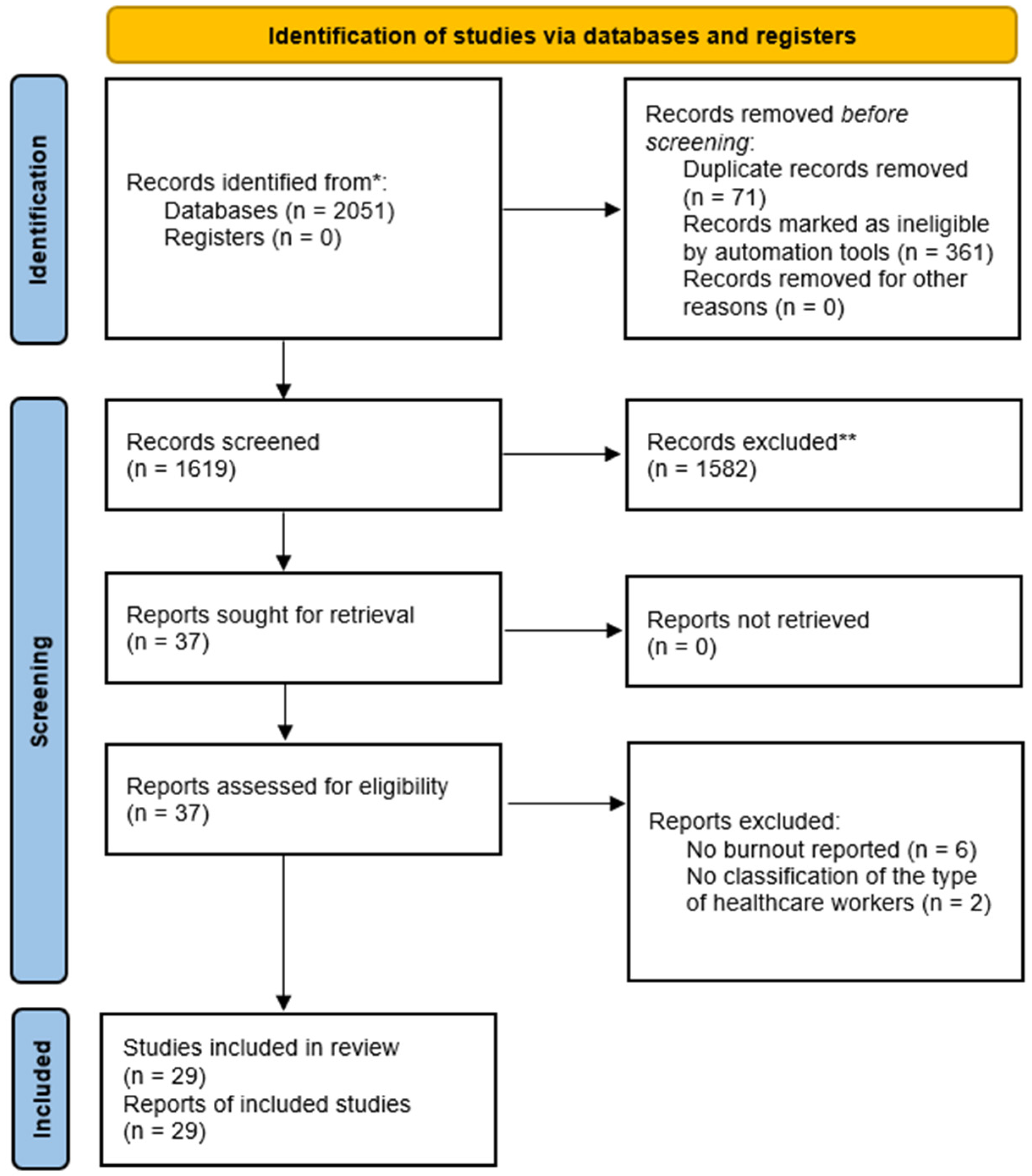


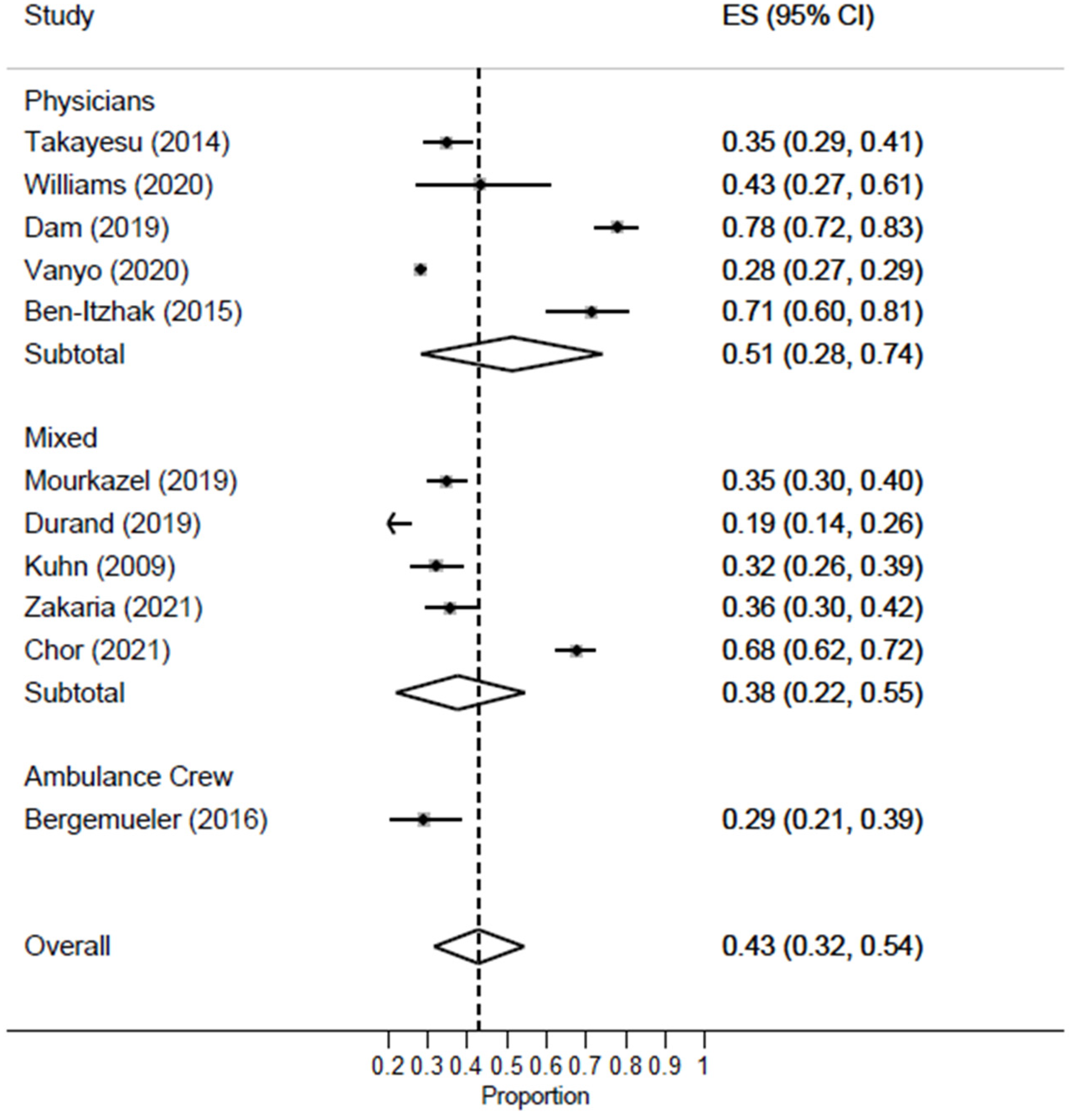

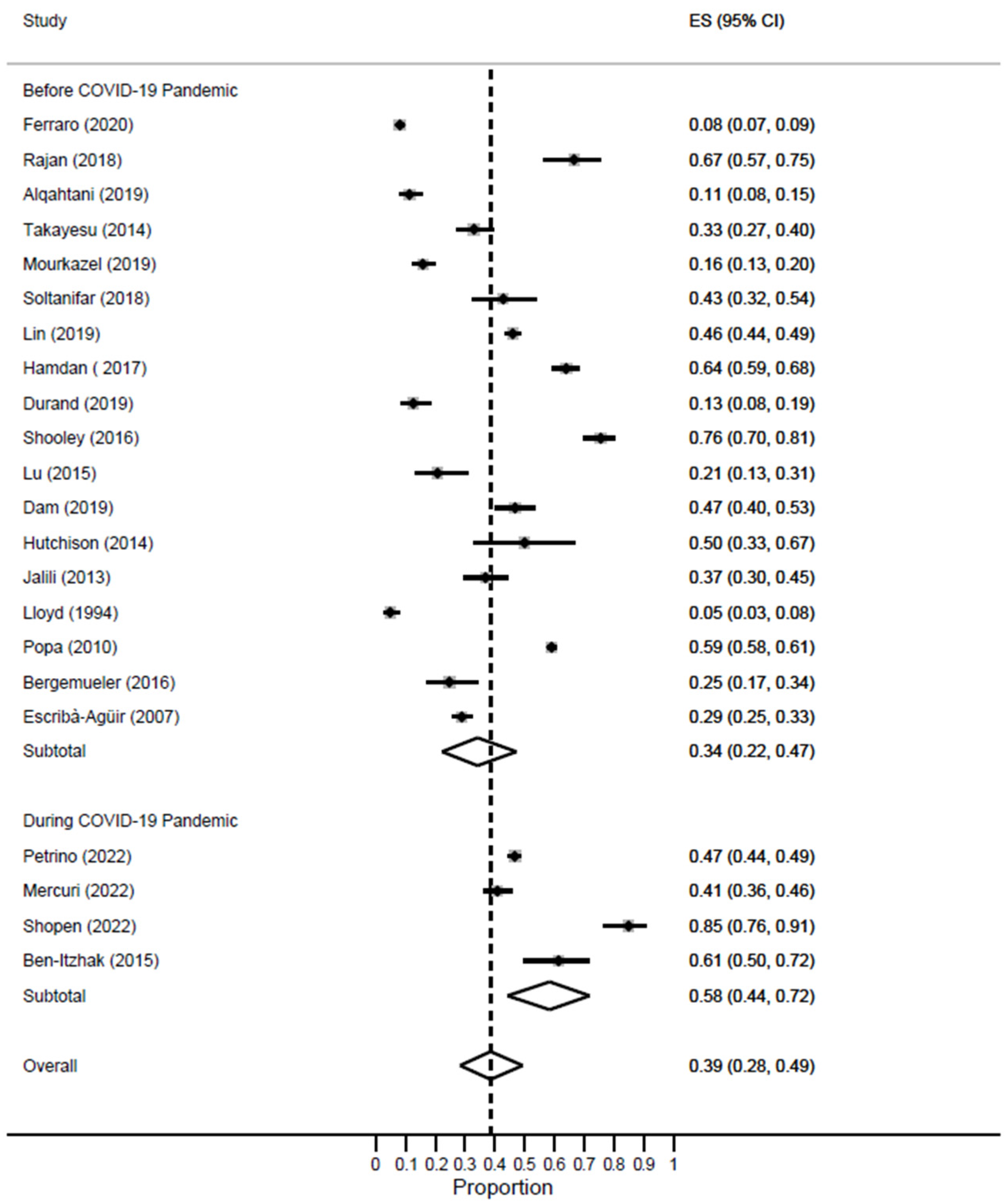
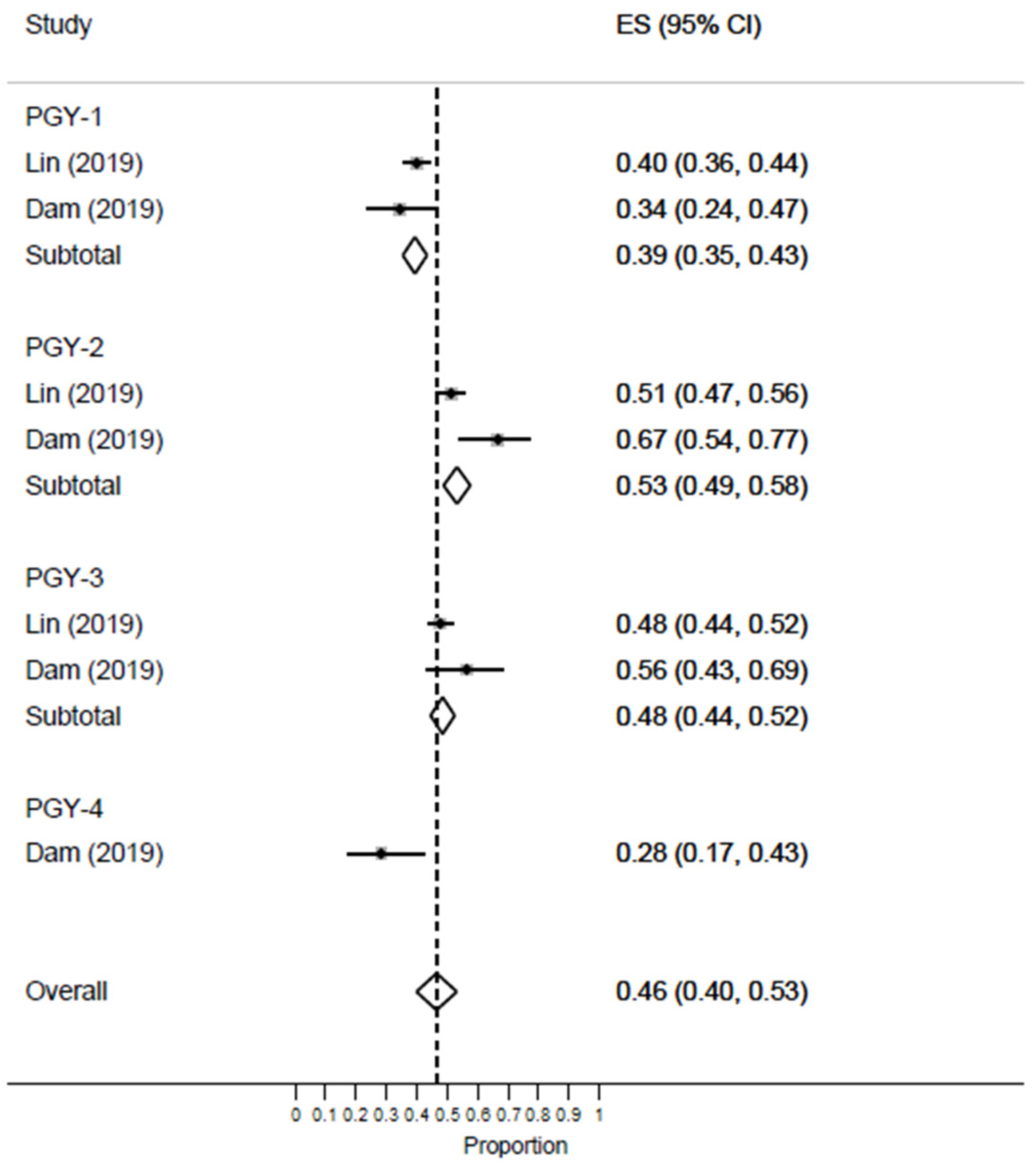
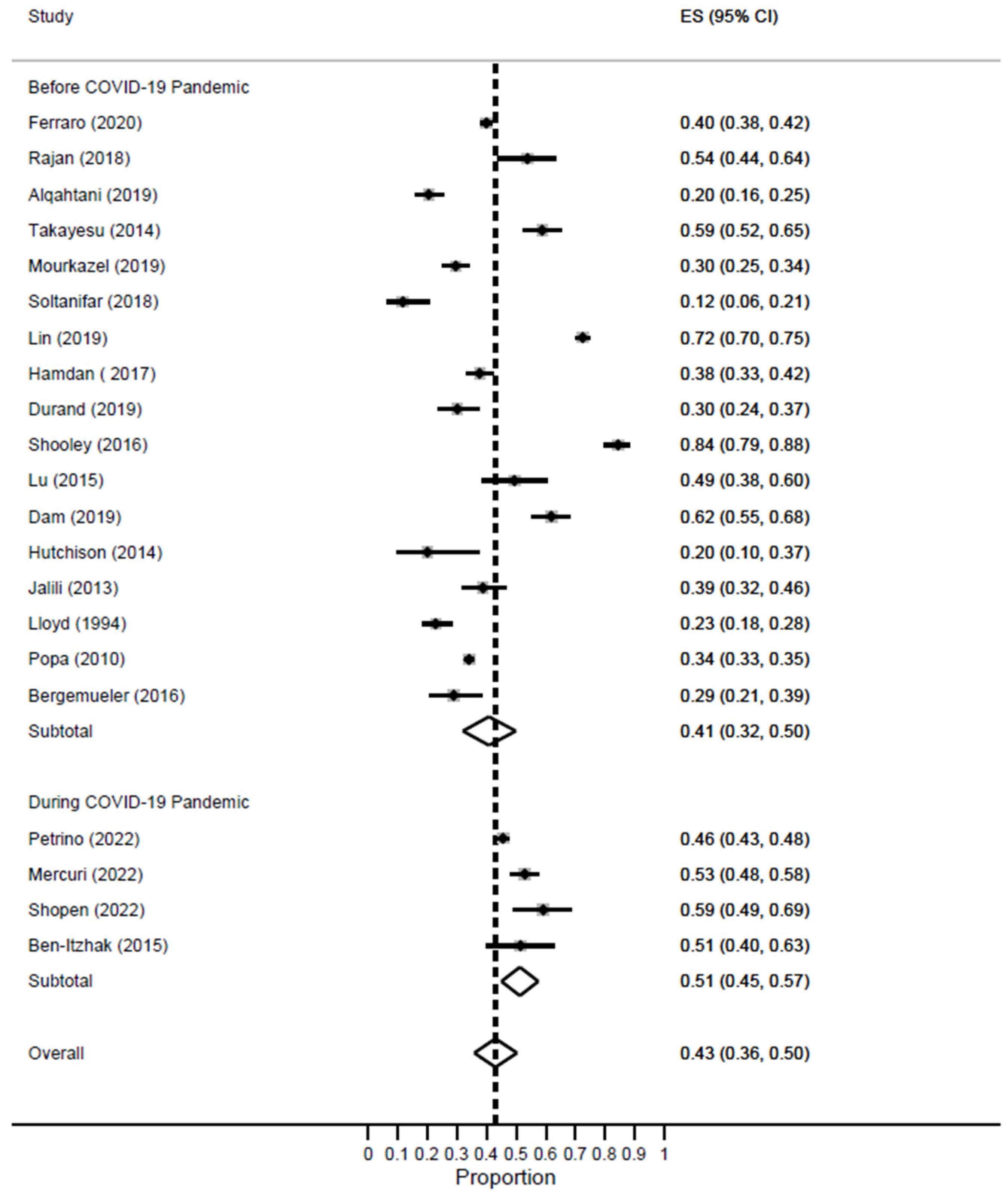
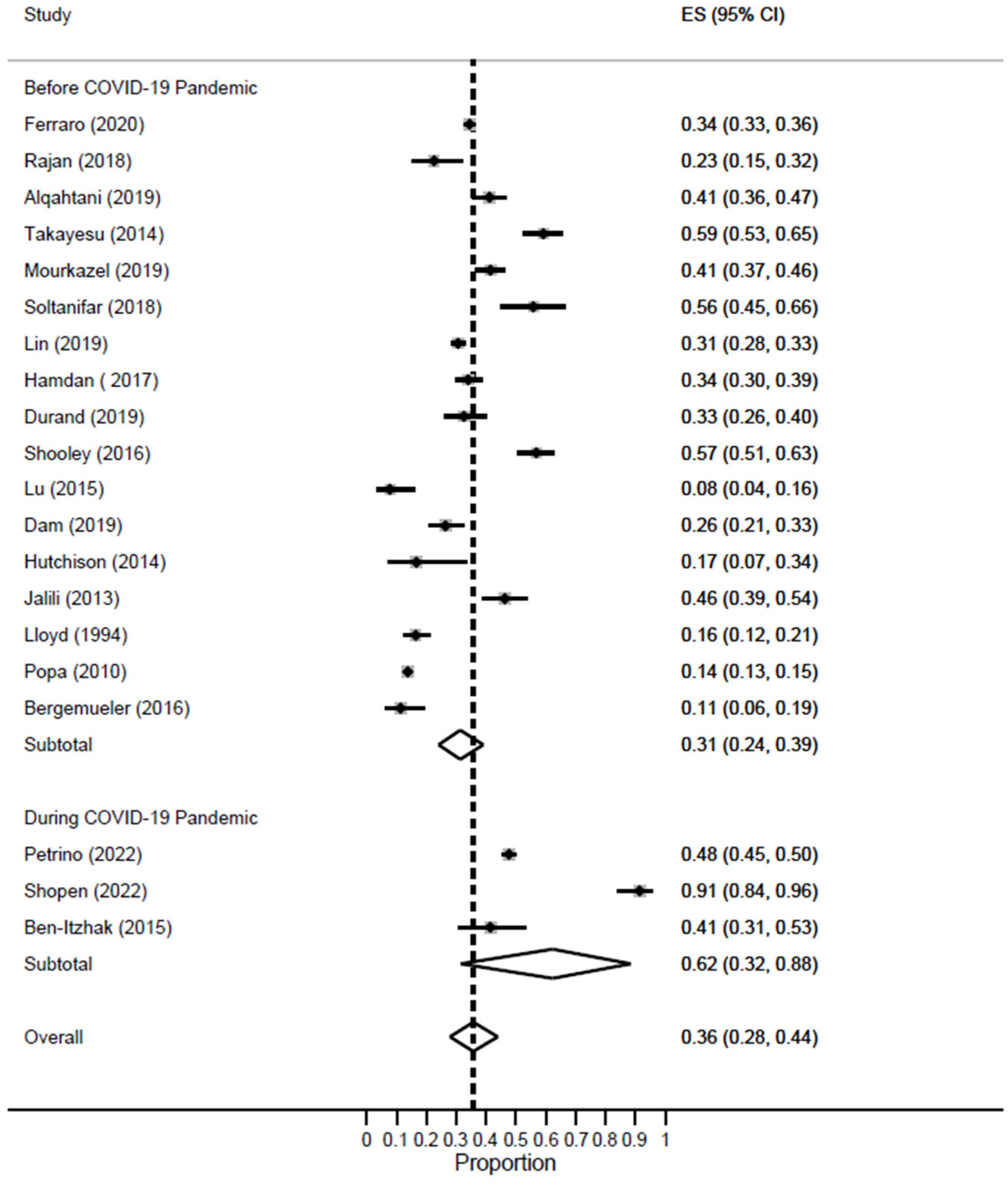

| Author (YOP) | Study Design | Country | Population | Sample | Age (Mean) | Male | Female |
|---|---|---|---|---|---|---|---|
| Ferraro (2020) [11] | CS | Italy | Ambulance Crew | 2361 | 34.8 | 2090 | 594 |
| Rajan (2018) [36] | CS | South Africa | Physicians | 100 | 35.1 | 42 | 51 |
| Alqahtani (2019) [8] | CS | Saudi Arabia | Mixed | 282 | 37 | 82 | 200 |
| Takayesu (2014) [5] | CS | USA | Physicians | 218 | 31.2 | 129 | 89 |
| Mourkazel (2019) [32] | CS | France | Mixed | 379 | 37.4 | 98 | 279 |
| Soltanifar (2018) [39] | CS | Iran | Physicians | 77 | 36 | 0 | 77 |
| Lin (2019) [12] | CS | USA | Physicians | 1522 | 31.3 | 879 | 643 |
| Hamdan (2017) [26] | CS | Palestine | Mixed | 444 | 32.5 | 341 | 103 |
| Williams (2020) [40] | CS | USA | Physicians | 30 | 32.1 | - | - |
| Durand (2019) [10] | CS | France | Mixed | 166 | 37.7 | 33 | 133 |
| Schooley (2016) [37] | CS | Turkey | Mixed | 250 | - | 135 | 115 |
| Lu (2015) [31] | CS | USA | Physicians | 77 | - | 48 | 29 |
| Dam (2019) [23] | CS | USA | Physicians | 222 | 31.8 | 150 | 70 |
| Hutchison (2014) [27] | CS | Jamaica | Physicians | 30 | - | 12 | 15 |
| Jalili (2013) [28] | CS | Iran | Physicians | 165 | 33.6 | 150 | 14 |
| Lloyd (1994) [30] | CS | Canada | Physicians | 268 | 38 | 233 | 35 |
| Kuhn (2009) [29] | CS | USA | Mixed | 193 | - | 140 | 53 |
| Patterson (2020) [33] | CS | UK | Physicians | 131 | - | 52 | 79 |
| Popa (2010) [35] | CS | USA | Mixed | 4725 | 33.6 | 3213 | 1512 |
| Erdur (2015) [24] | CS | Turkey | Physicians | 174 | 36.8 | 138 | 36 |
| Bergemueler (2016) [20] | CS | Germany | Ambulance Crew | 97 | 37 | 40 | 57 |
| Escribà-Agüir (2007) [25] | CS | Spain | Mixed | 639 | - | 356 | 279 |
| Petrino (2022) [34] | CS | Turkey | Mixed | 1925 | - | 1007 | 915 |
| Mercuri (2022) [13] | CS | Canada | Physicians | 416 | 44 | 220 | 196 |
| Chang (2021) [9] | CS | USA | Physicians | 22 | - | - | - |
| Bhanja (2021) [21] | CS | USA | Mixed | 944 | 39.3 | 221 | 421 |
| Shopen (2022) [38] | CS | Israel | Physicians | 88 | - | 59 | 29 |
| Chor (2021) [22] | CS | Singapore | Mixed | 337 | - | 109 | 228 |
| Ben-Itzhak (2015) [19] | CS | Singapore | Physicians | 337 | - | 49 | 21 |
| Author (YOP) | Selection | Comparability | Outcomes | Overall Rating |
|---|---|---|---|---|
| Ferraro (2020) [11] | 4 | 2 | 2 | Good |
| Rajan (2018) [36] | 3 | 2 | 2 | Good |
| Alqahtani (2019) [8] | 4 | 2 | 2 | Good |
| Takayesu (2014) [5] | 3 | 0 | 2 | Poor |
| Mourkazel (2019) [32] | 3 | 2 | 2 | Good |
| Soltanifar (2018) [39] | 2 | 2 | 2 | Fair |
| Lin (2019) [12] | 3 | 2 | 2 | Good |
| Hamdan (2017) [26] | 3 | 2 | 2 | Good |
| Williams (2020) [40] | 3 | 0 | 2 | Poor |
| Durand (2019) [10] | 2 | 2 | 2 | Fair |
| Schooley (2016) [37] | 3 | 2 | 2 | Good |
| Lu (2015) [31] | 2 | 2 | 2 | Fair |
| Dam (2019) [23] | 3 | 2 | 2 | Good |
| Hutchison (2014) [27] | 3 | 2 | 2 | Good |
| Jalili (2013) [28] | 4 | 0 | 2 | Poor |
| Lloyd (1994) [30] | 3 | 2 | 2 | Good |
| Kuhn (2009) [29] | 3 | 2 | 2 | Good |
| Patterson (2020) [33] | 4 | 2 | 2 | Good |
| Popa (2010) [35] | 2 | 0 | 2 | Poor |
| Erdur (2015) [24] | 4 | 2 | 2 | Good |
| Bergemueler (2016) [20] | 3 | 0 | 2 | Poor |
| Escribà-Agüir (2007) [25] | 2 | 0 | 2 | Poor |
| Petrino (2022) [34] | 4 | 2 | 2 | Good |
| Mercuri (2022) [13] | 3 | 0 | 2 | Poor |
| Chang (2021) [9] | 4 | 2 | 2 | Good |
| Bhanja (2021) [21] | 2 | 2 | 2 | Fair |
| Shopen (2022) [38] | 3 | 2 | 2 | Good |
| Chor (2021) [22] | 2 | 2 | 2 | Fair |
| Ben-Itzhak (2015) [19] | 3 | 2 | 2 | Good |
Disclaimer/Publisher’s Note: The statements, opinions and data contained in all publications are solely those of the individual author(s) and contributor(s) and not of MDPI and/or the editor(s). MDPI and/or the editor(s) disclaim responsibility for any injury to people or property resulting from any ideas, methods, instructions or products referred to in the content. |
© 2023 by the authors. Licensee MDPI, Basel, Switzerland. This article is an open access article distributed under the terms and conditions of the Creative Commons Attribution (CC BY) license (https://creativecommons.org/licenses/by/4.0/).
Share and Cite
Alanazy, A.R.M.; Alruwaili, A. The Global Prevalence and Associated Factors of Burnout among Emergency Department Healthcare Workers and the Impact of the COVID-19 Pandemic: A Systematic Review and Meta-Analysis. Healthcare 2023, 11, 2220. https://doi.org/10.3390/healthcare11152220
Alanazy ARM, Alruwaili A. The Global Prevalence and Associated Factors of Burnout among Emergency Department Healthcare Workers and the Impact of the COVID-19 Pandemic: A Systematic Review and Meta-Analysis. Healthcare. 2023; 11(15):2220. https://doi.org/10.3390/healthcare11152220
Chicago/Turabian StyleAlanazy, Ahmed Ramdan M., and Abdullah Alruwaili. 2023. "The Global Prevalence and Associated Factors of Burnout among Emergency Department Healthcare Workers and the Impact of the COVID-19 Pandemic: A Systematic Review and Meta-Analysis" Healthcare 11, no. 15: 2220. https://doi.org/10.3390/healthcare11152220
APA StyleAlanazy, A. R. M., & Alruwaili, A. (2023). The Global Prevalence and Associated Factors of Burnout among Emergency Department Healthcare Workers and the Impact of the COVID-19 Pandemic: A Systematic Review and Meta-Analysis. Healthcare, 11(15), 2220. https://doi.org/10.3390/healthcare11152220






